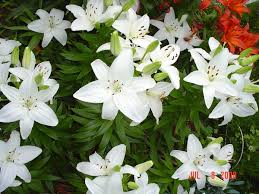Lilies


Lilies
The term 'lily' has become somewhat corrupted over the millennia, which is rather ironic for a flower that is
almost worldwide renowned for its symbolism of purity, cleanliness of soul and innocence. For many flowering plants
that are called lilies are not really lilies at all!
Neither water lilies nor Lilies-of-the-Valley are true lilies, although they are probably the two most famous
'lilies' in the western hemisphere. Ask anyone to name a famous lily and water lily must come in as number one.
True lilies are usually grown from bulbs, not seeds and most original species, not modern hybrids, come from the
temperate climates of the northern hemisphere.
Oriental lilies are usually hybrids, not true varieties, as beautiful as Asiatic lilies may be.
The botanic name is lilium and is most often considered to be derived from the ancient Greek word 'leirion'
meaning 'true' or 'pertaining to the truth'.
The flowering blooms of lilies are often large and fragrant and come in a wide variety of colours, although many
people consider the 'white lily', like the 'Madonna Lily', the only true colour for a lily to be. However, some
species have spots or stripes or both, as do the varieties of tiger lilies.
The Tiger Lily is one of the most popular of the lilium family because of its unusual markings.
In a temperate climate, lilies can flower in any of the four seasons from spring until autumn, so except winter,
giving the thoughtful lily gardener a colourful garden throughout the warmer months, as the lily will retreat into
its bulb to overwinter.
Lilies have the reputation for being poisonous, but this is not the whole picture. Some bugs, especially the
scarlet lily beetle and larvae prey on the lily stems and bulbs while some lilies are mildly toxic to humans but
deadly to pet cats. In these cases, even the lily pollen on their coats can cause renal failure when it is licked
off.
Lilies are best planted as bulbs in a south-facing, well drained area during the dormant period. Lilies need
to-be planted as soon as possible after purchase as lily bulbs do not have a 'tunic' to prevent them from drying
out. If this happen, your lily may not grow or may be deformed.
Bulbs should be planted 6"-7" deep and 6"-7" apart, unless you have more specific information relating to your
species, in a slightly acidic and well-draining soil. Taller species may need staking. Lilies like grow in the
open, but will flourish in containers if tended carefully.
'Lily' has been a popular girl's name in both the West and the East for millennia and is universally associated
with purity, truth, candour and, by extension, to purification through rebirth and, therefore, death. This is why
lilies are often seen at funerals, which has earned them the nickname of the' Death Flower' or the' Flower of
Death' somewhat unfairly.
The purity associated with the lily is demonstrated in the Bible by the symbolism of the white lily, a species
of which is now called the 'Madonna Lily'. White is the global symbol of purity and righteousness and, in the Far
East, worn at many funerals, to symbolise purity after rebirth, as stated above.
Some interesting facts:
*Lilies make wonderful cut flowers
* 'water lilies' are often confused with Lotus Flowers, although they are completely unrelated.
by +Owen Jones
| 







 Delicious
Delicious Digg
Digg Facebook
Facebook Google Bookmarks
Google Bookmarks Livejournal
Livejournal Reddit
Reddit Stumbleupon
Stumbleupon Twitter
Twitter